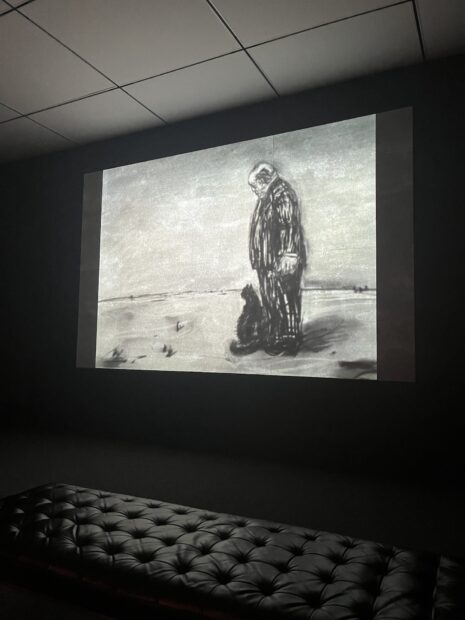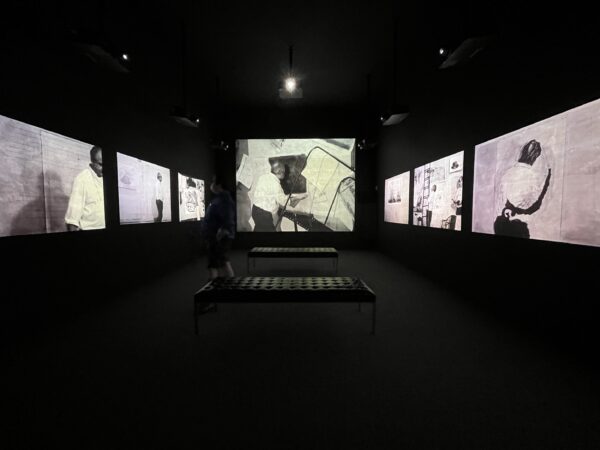Jessica Fuentes (JF): I can’t recall exactly when I first saw the work of South African artist William Kentridge, but as an avid doodler with an interest in time-based media, I do know that it opened my eyes to a new possibility of what art could be beyond the traditional oil paintings and marble sculptures that filled my high school art textbook. Long before I realized the weight of the stories his work told, I was mesmerized by the process of his charcoal drawings, which are brought to life through stop-motion animation.
In 2009, when the Modern Art Museum of Fort Worth presented William Kentridge: Five Themes, a survey of the artist’s work including animated films, drawings, prints, and sculptures, I visited several times to sit with and take in the films. A few years later I had the chance to see some of the same films at the Rachofsky Warehouse and the Dallas Museum of Art. And throughout the years, in my role as an educator in classrooms and higher education, I continued to keep Kentridge in my curriculum because of the effect his work had on students — they too were captivated by the magic of his artistic process.
So, when the Museum of Fine Arts, Houston (MFAH) announced that it would be presenting William Kentridge: In Praise of Shadows, I added a Houston trip to my summer plans. Glasstire Publisher Brandon Zech and I visited the exhibition together in mid-July and spent about two hours watching films, looking closely at drawings, and talking about art.
So Brandon, now that it has been about two weeks since our visit, what sticks with you the most from the experience?
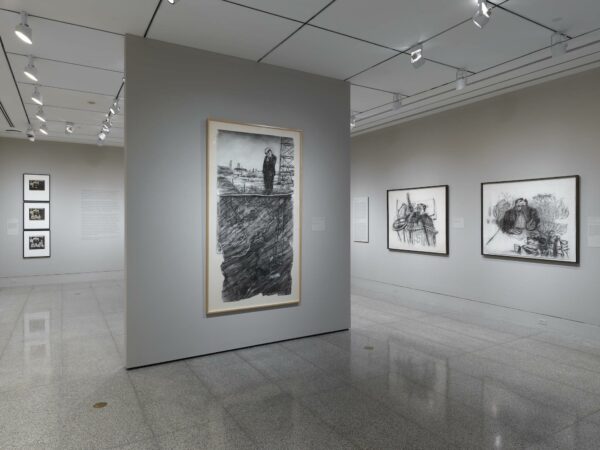
“William Kentridge: In Praise of Shadows,” on view at the Museum of Fine Arts, Houston, 2023. Photo: the Museum of Fine Arts, Houston
Brandon Zech (BZ): Our visit was quite different from my first trip through the show, which was during a press preview. It was nice to have Alison de Lima Greene, this presentation’s organizing curator, walk us through and talk about the work, the guiding principles of the show, and her relationship with Kentridge (the show is organized by The Broad and its curator (and sometimes Glasstire contributor) Ed Schad). However, no matter how great a guided walkthrough of Kentridge is, there’s no substitute for taking real time to engage with his work.
The MFAH owns and has shown some of his films before, in the museum’s large Cullinan Hall space. Whenever they do, there’s always an audience that gathers and is stupefied by them — what you’re saying about the power of the films particularly is completely on the mark. I was pleased at how this exhibition was able to include so many kinetic and video pieces. While the galleries aren’t small, incorporating video into shows isn’t easy, and with Kentridge, video is the bread and butter — the ultimate product — of the work.
The real heart of this show is the video room just off of the first gallery, which plays, in chronological order, a series of 11 films created between 1989 and 2020. This was the largest survey of his work I had ever seen, and while sitting in the room to watch all of them is a commitment, I think the films alone accomplish what I want from a survey exhibition: the pieces provide a demonstrable progression of his career as an artist. While we were watching, since we were in the room for over an hour, we also were able to see how visitors were struck by the work. People didn’t pop in and out, but instead came in, sat down, and stayed.
The videos have a power to them because they are narrative-based, but accessible whenever you walk in; even though there’s a beginning and an end, you can come into the story mid-sentence and be able to follow the figures’ voyages. Watching them made me think about video art that accomplishes similar goals, and harkened back to a piece I wrote seven years ago about artists who break the narrative trap of video art. I think much of this is accomplished in Kentridge’s work through the excellent use of music and sound design, too (musicians and audio effects artists are credited on each video, which also to me says that Kentridge recognizes their significant contributions to the works).
What was your take away from the video pieces? Was it different seeing them like this compared to the Modern’s show? We also spent some time talking about the adjacent gallery, which was filled with drawings, which are working stills from the videos.
JF: I think beyond the shift in production value over the decades of Kentridge’s work, the most striking thing to me was how consistent it has been. His characters, his drawing style, his color palette, the themes he approaches — it all has remained remarkably consistent over the years without feeling stale. At least, this is true of the works in the main video room, which are the ones most people probably associate with him. Some of his other animations across the exhibition are quite different in style and presentation.
I have a terrible memory for specifics, so I’m not sure if what I’m remembering of the Modern’s exhibition is accurate or just my memory of it, but I seem to recall most (if not all) of the video pieces having their own space throughout the galleries. In my mind that gave more prominence to the video work as the main focus of the exhibition. At the MFAH, I found myself worrying that if someone didn’t know better, they might assume the drawings, which are in fact relics of the video animations, are the thing to see; they could easily walk by the first video room without understanding the significance of what is unfolding in there.
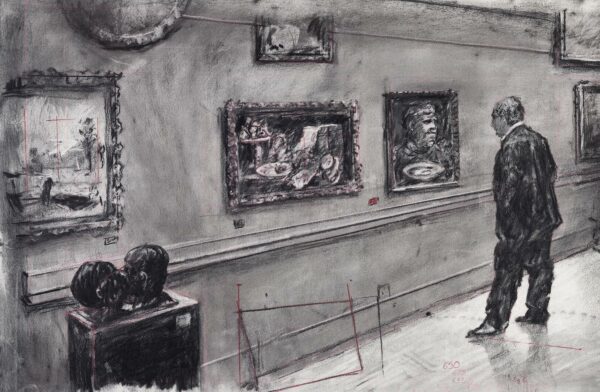
A still image from William Kentridge’s “City Deep,” 2020, HD video. The Museum of Fine Arts, Houston, purchased jointly by the MFAH with funds from the Caroline Wiess Law Accessions Endowment Fund, and by the National Gallery of Art. © William Kentridge.
Of course, the drawings themselves are fascinating. Sitting with a singular frame of Kentridge’s animations really puts into perspective the amount of labor that goes into each of his films. I think my favorite part of the drawings was seeing the small margin notes and markings in red that signal some information about filming, including timing and pans.
Beyond those first few rooms, I was most surprised about and excited to see Kentridge’s sculptures. I don’t think I had ever seen his kinetic sculptures, and I associate him so much with films that I hadn’t expected to see sculptural works. And just like his animations, one particular kinetic sculpture, Singer Trio, was hypnotic. The piece is a Dadaesque and surreal combination of sewing machines and metal cones activated by a combination of gears, chains, and wooden rulers, and emits a haunting audio track; it caught me completely off guard. In general, the whimsy of Kendtridge’s work is at first surprising, then compelling, and ultimately has a transformative power.
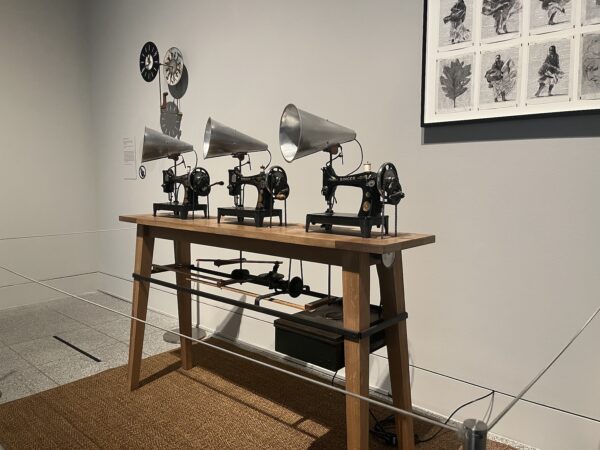
William Kentridge, “Singer Trio,” 2019, Singer sewing machines, four breast drills, antique wood rulers, mild steel, aluminum, wood, and electronics. Audio composition by Nhlanhla Mahlangu. Sound design by Gavan Eckhart. Technical design and construction by Chris-Walo de Wet and Jacques van Staden. Software design by Janus Fouché.
Were you familiar with Kentridge’s sculptures? What were your thoughts about the kinetic sculptures and the other sculptural pieces later in the exhibition?
BZ: I really wasn’t. Other than the videos, I feel that we generally don’t have a whole lot of Kentridge in Texas, so the sculptures, artist books, and tapestry later in the show took me by surprise. His penchant for collaboration, though, made the sculptures make sense to me. If he’s up for handing over a significant creative aspect of the videos (the sound design) to others, then it follows that he’s also willing to collaborate with experts on woven works and bronze castings. It’s really the same sort of working process — collaborating with a master in their field to create the artist’s vision.
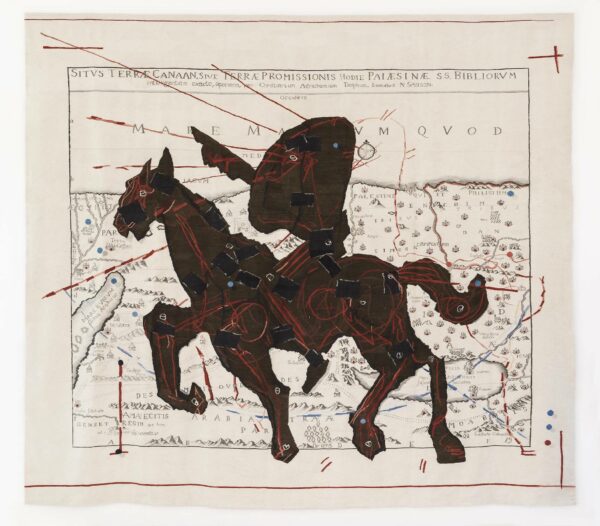
William Kentridge, “Promised Land,” 2008, hand-woven mohair tapestry, woven by Stephens Tapestry Studio, Johannesburg, South Africa, courtesy of the artist. © William Kentridge.
What I found interesting is that two pieces — a small-scale sculpture series and the huge tapestry — are both based around (or, came out of) the design work that Kentridge did for the Metropolitan Opera’s The Nose, which is a satirical story about a nose gaining its independence from its human’s face. The imagery is so striking — a huge figure with a nose for a head riding, heroically, on horseback — that you don’t really need to know the narrative, the background, or even that the imagery comes from an opera in order to at least somewhat follow along.
This gets to the heart of Kentridge’s work: he is a storyteller. I think some of this is a product of his upbringing (he comes from a family of lawyers — his father represented Nelson Mandela and Desmond Tutu), and, instead of spinning tales in front of a court, this form of creativity manifested in Kentridge in visual imagery. For the sculptures, you get that something is going on, and if you have more information you can piece it together. This isn’t to say that the work is obtuse or inaccessible — on the contrary, I think it has levels of engagement, which is what good art offers visitors.
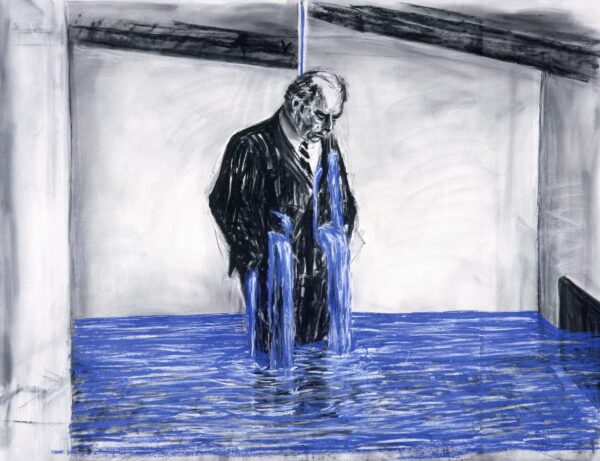
William Kentridge, “Stereoscope,” 1999, 35mm film, transferred to video. The Broad Foundation, Los Angeles. © William Kentridge
The same thing happens in his videos — in the main video room, we were discussing how the videos don’t hit you over the head with the idea that Kentridge is making work about South Africa’s national shame: apartheid. Instead, he focuses the narratives on his main character, Soho Eckstein, who is a stand-in for the country. But further than that, the videos let this pinstripe suit-wearing man be a proxy for whatever the viewers bring to them. This is where his talent and the ubiquitousness of his work comes in. It is about something very culturally specific, but he’s found a way to make it both palatable and accessible, while also not declawing it.
While walking through the show, we discussed this unique and effective middle ground his work uses to split the difference. We also saw that some of his later work, particularly the video 7 Fragments for Georges Méliès, turns in on itself to make Kentridge himself the focus; or, Kentridge as the proxy for the archetype of the artist. Do you think the show made evident any marked change in the approach or goals of his work?
JF: I’m not sure that it did, at least for me. I think partly because the show is organized thematically rather than chronologically, I didn’t find myself looking for or thinking about larger shifts in his work. Instead, I was taken by the variety of ways in which he has produced work and how, despite shifts in medium, he continues to highlight issues related to race and equity, generational harm and trauma, and colonialism, all through repetitive acts (like bronze casting, stop-motion animation, and kinetic sculpture).
But looking at the dates of when things were created, the most recent charcoal animation in the video room, City Deep, was made in 2020, whereas the last animated piece in the final room, Kaboom!, was created in 2017-2018. These works are quite different in their production, with City Deep following Kentridge’s iconic style of building up and erasing charcoal drawings and Kaboom! featuring an array of animation styles, including drawings, cut paper, and text. Despite their stylistic differences, the themes behind the works relate.
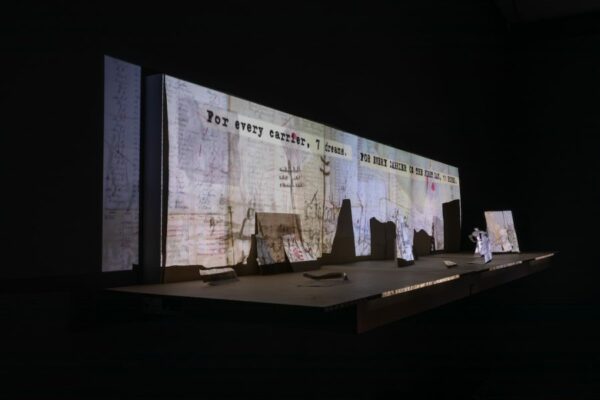
William Kentridge, “KABOOM!” (detail), 2018, three-channel HD film installation, model stage, paper props, found objects, and three mini projectors with stands. Installation view, the Institute of Contemporary Art/Boston, 2020-2021. Courtesy of the artist and Marian Goodman. Photo by Mel Taing. © William Kentridge. Photo: the Museum of Fine Arts, Houston
Did anything stand out to you regarding overarching shifts in his artistic practice over time?
BZ: This isn’t that unique of an answer, because the same could be said about many artists over the course of their careers, but he’s got his process down now — he knows how to make the work, and it comes off as polished. Not in an overly market-driven or disingenuous way, but more in a “I have honed my craft so now I can do different and bigger things” way.
I think this comes out in his set design for Mozart’s opera Magic Flute, which is on view in a spectacular 2005 miniature stage set-plus-video-projection that’s on loan from the Museum of Modern Art. I also felt this about the piece you mentioned, Kaboom!, in the last gallery. The work combines a multi-projector video with a sort of in-real-life stage/screen. The video is projected onto and interacting with the physical props.
I’m now realizing that these piece also represent an expanded focus for Kentridge — he’s widely known as the South African artist who makes political work about apartheid, but these two works explore concepts beyond that: one, a ubiquitous opera, the other, the under-known history of African porters in World War I. With a broadening of artistic approach comes a widening of subject — the same could be said for his sculptures drawing from The Nose we talked about above.
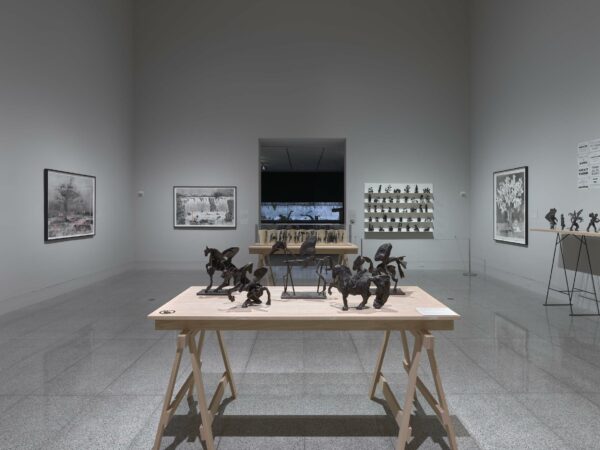
“William Kentridge: In Praise of Shadows,” on view at the Museum of Fine Arts, Houston, 2023. Photo: the Museum of Fine Arts, Houston
This leads me to the thought that Kentridge is much more multidimensional than he might seem on paper. His work is serious, but has a playfulness and humor that helps prove whatever point he is trying to make.
JF: Right! I think it’s easy to pigeonhole Kentridge as the artist who brings charcoal drawings to life via animations that tell heavy stories about South Africa, but I often forget that at heart he is a performance artist. There is a performative element in everything he creates, and imbued in that is also a fascination with the absurd. This playful spirit and humor he brings to his artistic process is what keeps audiences engaged. Though his works are narrative-based, their whimsy means you can’t anticipate what will happen next. Then, with a captive audience, Kentridge brings to light some of the darkest parts of history.
William Kentridge: In Praise of Shadows is organized by The Broad, Los Angeles and its curator, Ed Schad. The Houston presentation is organized by Alison de Lima Greene. The exhibition is on view at the Museum of Fine Arts, Houston through September 10, 2023.


